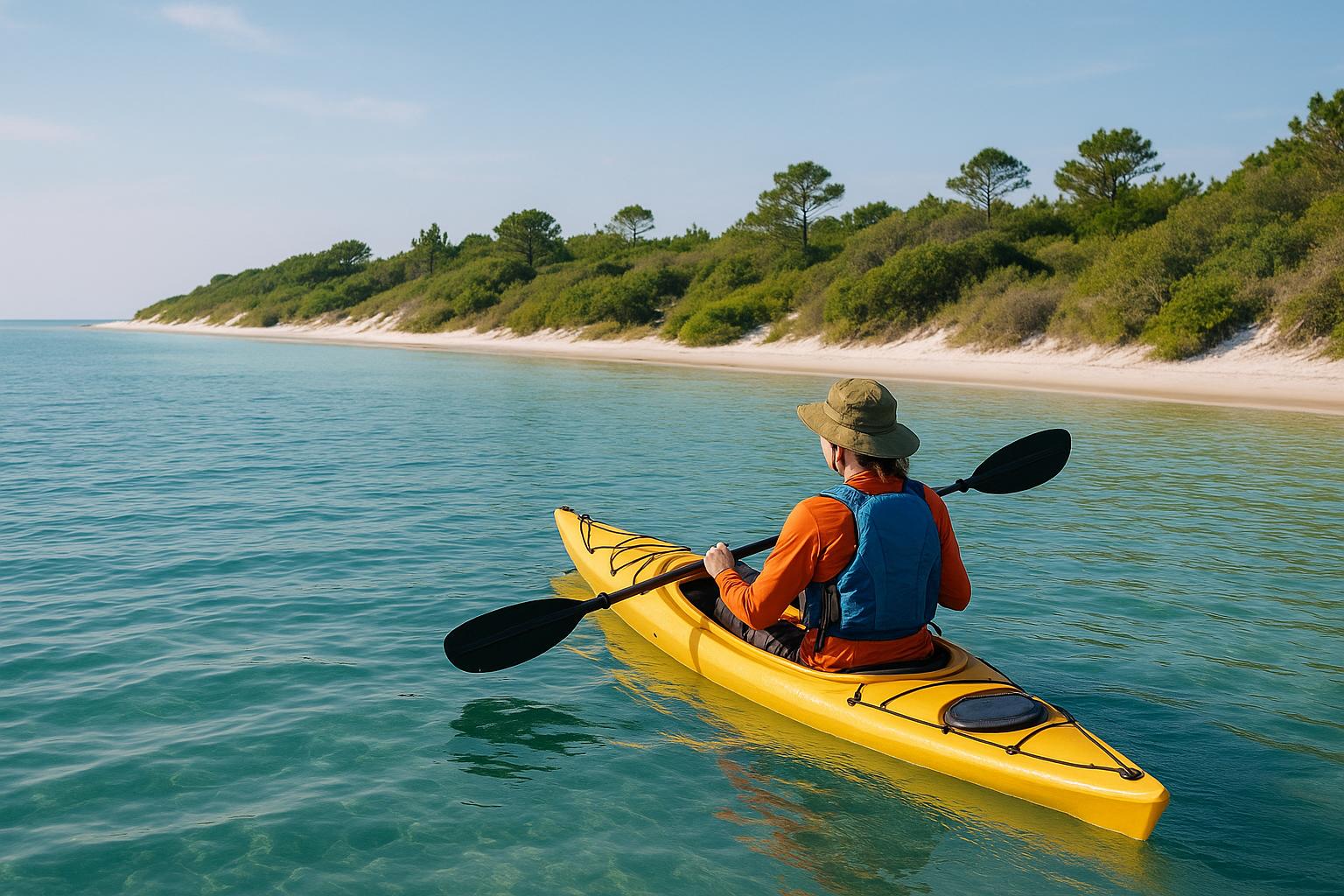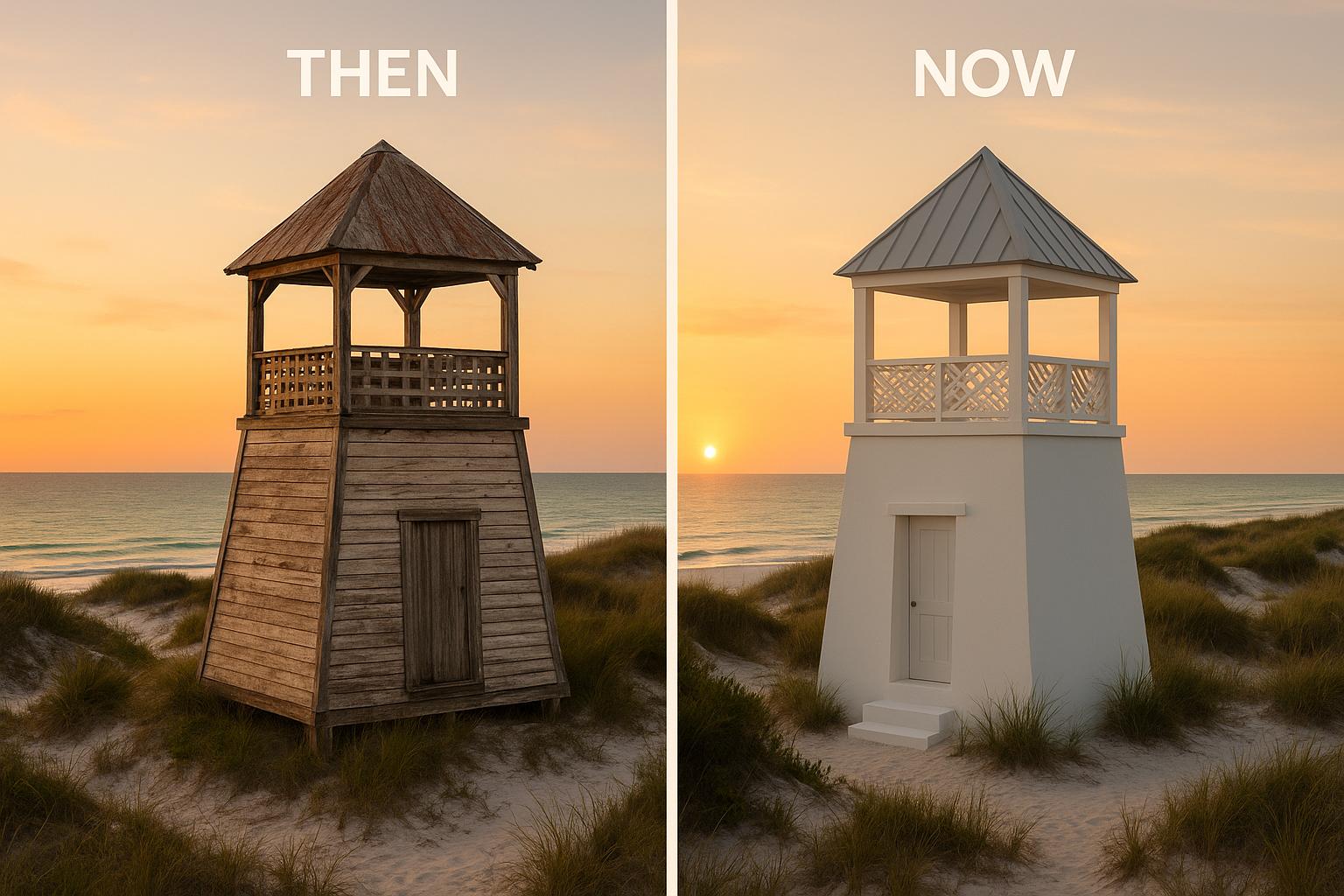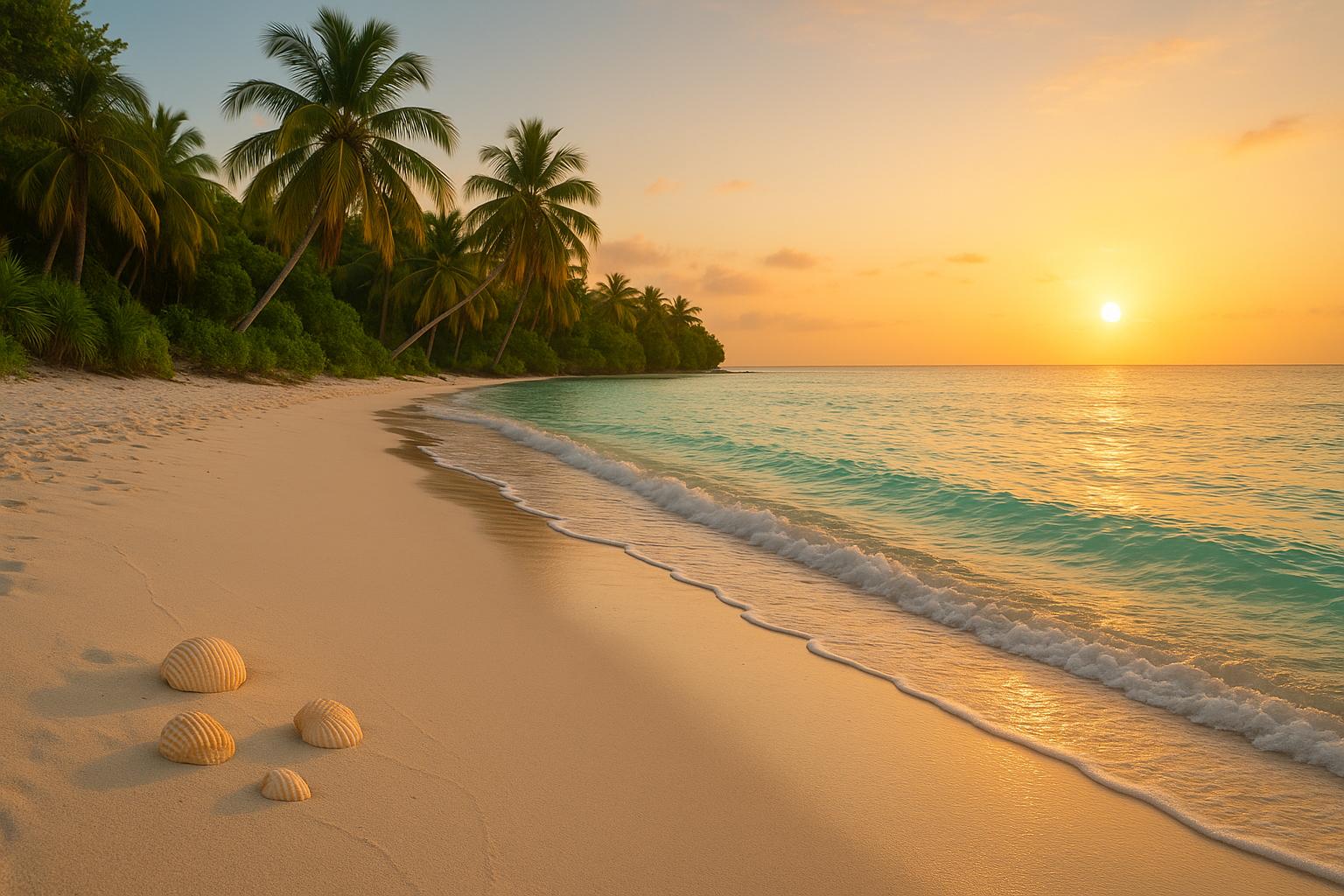Looking for serene spots to elevate your nature photography in Walton County? Beyond the bustling beaches, these hidden parks offer tranquil landscapes, rare wildlife, and diverse ecosystems. Here's a quick guide to five must-visit locations:
- Grady Brown Park: Enjoy bay views, sandy shores, and birdwatching near US Highway 331.
- Morrison Springs Park: Crystal-clear springs and lush woodlands perfect for water and wildlife shots.
- Lakewood Park: Oak hammocks and lakefront views in DeFuniak Springs.
- Deer Lake State Park: Coastal dune lakes, wildflowers, and Gulf vistas along Scenic Highway 30A.
- Campbell Lake at Topsail Hill Preserve: Mirror-like reflections and sand dunes in a peaceful setting.
Each park offers unique backdrops, from pristine lakes to dense forests. Visit during sunrise or sunset for soft lighting and active wildlife. Whether you're after wide landscapes or detailed close-ups, these parks provide endless opportunities. Respect the trails and wildlife, and enjoy the beauty Walton County has to offer.
Jeff Talbert presents "Walton County State Parks" 2017
1. Grady Brown Park
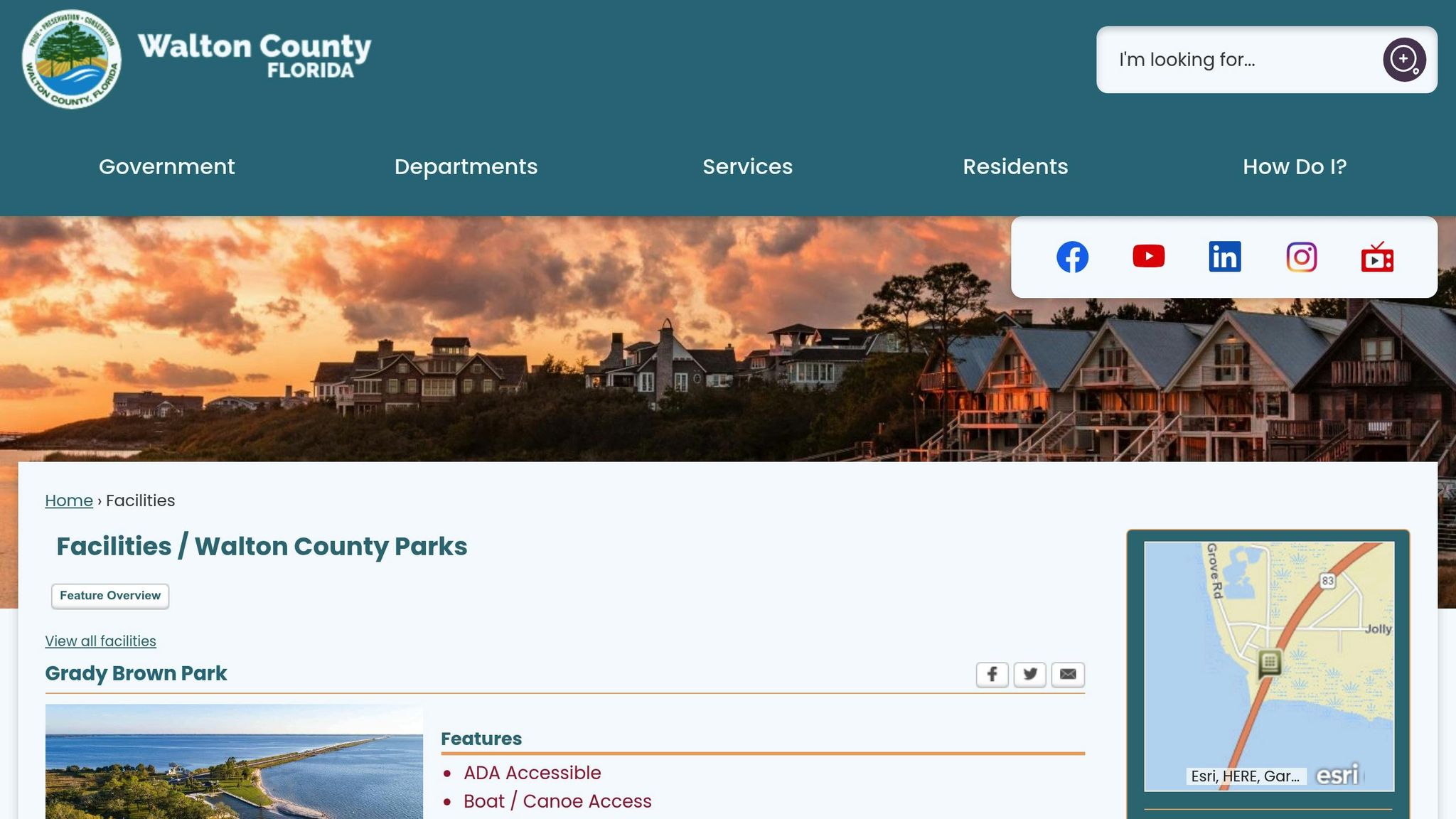
Nestled by the Clyde B. Wells Bridge along US Highway 331, Grady Brown Park is a hidden treasure that combines serene bay views with abundant wildlife. Situated on the north side of the Choctawhatchee Bay, this park offers a peaceful escape and a chance to experience Florida's natural beauty up close. It's particularly appealing for photographers seeking unique shots of inland waters and the rich ecosystems they support.
Photography Opportunities
Grady Brown Park is a dream for photographers. Its sandy beach along the Choctawhatchee Bay provides picturesque settings for wide-angle shots, complete with tranquil reflections on the water. The three finger piers extending into the bay add depth and symmetry to compositions, offering an ideal vantage point for capturing the bay’s surface and the wildlife that frequents the area.
Birdwatching enthusiasts will find plenty to love here. The park’s location attracts a variety of species, from wading birds hunting in the shallows to majestic raptors soaring overhead. The two boat ramps often create lively scenes, adding a dynamic element to your photos as people launch and dock their boats.
Access and Amenities
You’ll find Grady Brown Park conveniently located at 20940 US Highway 331 South, Freeport, FL 32439. It’s easily reachable by car, with plenty of parking available for both regular vehicles and boat trailers. The park is equipped with restroom facilities and paved sidewalks, ensuring a comfortable experience for extended visits.
Accessibility is a priority here, with a handicapped-accessible kayak launch and full ADA compliance, making the park welcoming to photographers of all abilities. Picnic areas are also available, allowing you to relax and recharge while waiting for the perfect light or wildlife activity.
Landscape Variety
The park offers a diverse range of scenes to inspire your creativity. From sandy shores and long piers to the expansive bay, the variety allows for everything from close-up wildlife shots to sweeping landscape vistas.
Best Photography Times
For the best lighting, plan your visit during the Golden Hour (1–2 hours after sunrise or before sunset) or the Blue Hour (20–30 minutes after sunrise or sunset). These times provide soft, dramatic lighting that enhances the mood of your photos. Avoid shooting between 10 AM and 3 PM when the harsh midday sun can create unflattering shadows and overexposed highlights.
The months of January through June are ideal for photography in Florida, offering comfortable weather with lower heat and humidity, minimal hurricane activity, and calmer winds. Arriving early during the Golden or Blue Hour gives you time to explore the park and prepare for those fleeting, magical moments that make for unforgettable shots.
2. Morrison Springs Park
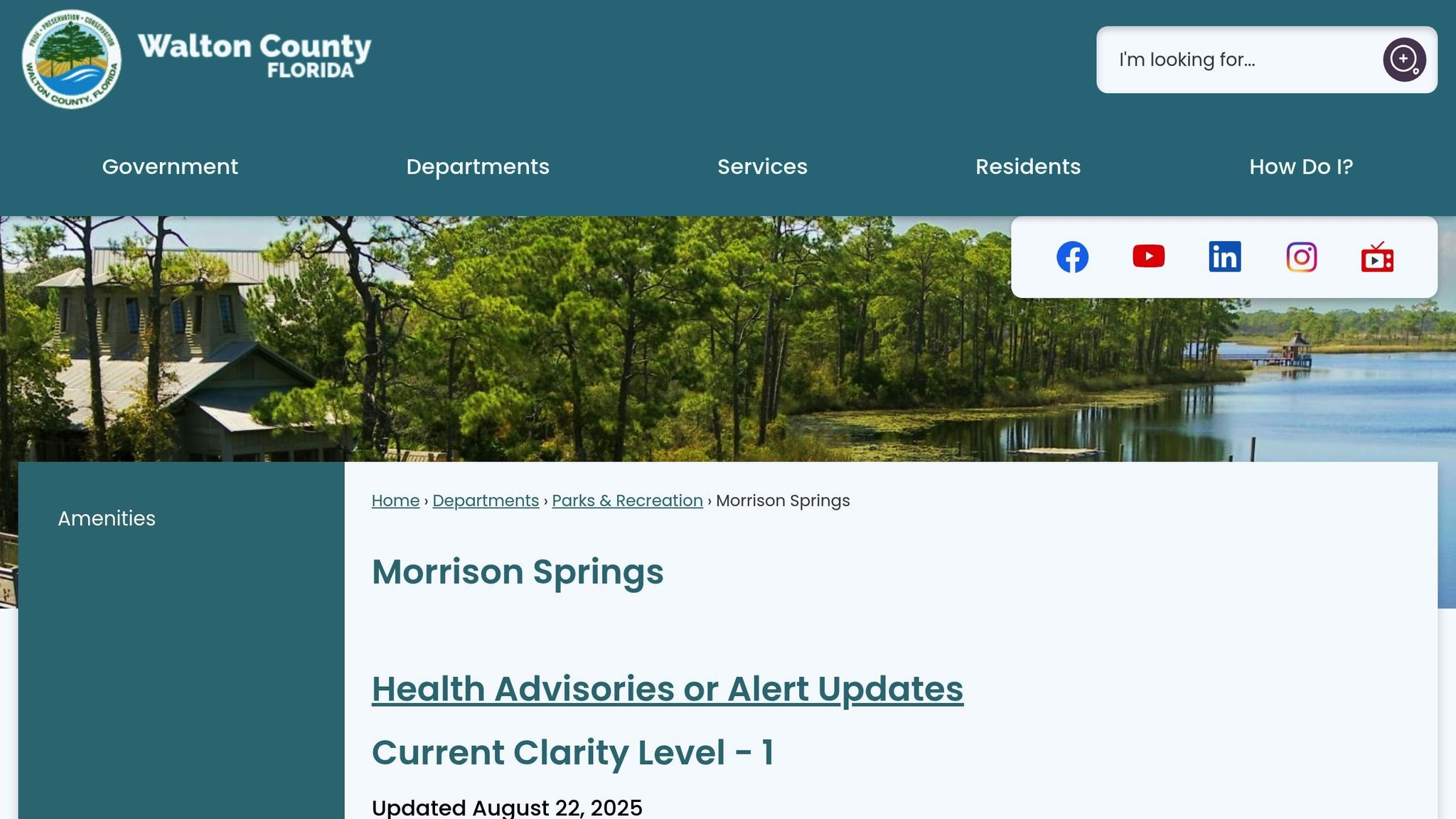
Nestled in Ponce de Leon, Morrison Springs Park is a haven for photographers looking to capture Florida's pristine spring waters and lush subtropical scenery. The park's natural spring provides a stunning backdrop that shifts with the light and seasons, offering endless creative possibilities for photography enthusiasts. Let’s dive into what makes Morrison Springs Park a unique spot for capturing nature at its finest.
Photography Opportunities
The park features designated viewing areas that offer elevated vantage points of the spring and its surroundings. These spots are perfect for experimenting with creative compositions, whether you're drawn to the soft reflections on the water's surface or the chance to photograph local wildlife like turtles and waterfowl. Every corner of the park invites you to frame a unique shot.
Access and Amenities
Morrison Springs Park is easily accessible via Morrison Springs Road and offers plenty of conveniences for visitors. You'll find ample parking, clean restrooms, picnic areas, and well-maintained trails that make it easy to explore with your photography gear. Just remember to wear sturdy footwear, especially if you’re navigating wet or slippery surfaces.
Diverse Landscapes
What sets Morrison Springs Park apart is its blend of woodlands and water features, creating a variety of backdrops for photographers. Whether you're capturing wide, sweeping landscapes or focusing on the intricate details of the park's flora and fauna, the diversity here ensures no two shots look the same.
Best Times for Photography
For the best shots, plan your visit early in the morning. The soft, diffused light at this time enhances the spring's natural beauty and creates a tranquil atmosphere perfect for photography. Later in the day, harsher lighting can introduce strong contrasts, so aim to arrive early for the most flattering conditions and fewer distractions from other visitors.
3. Lakewood Park
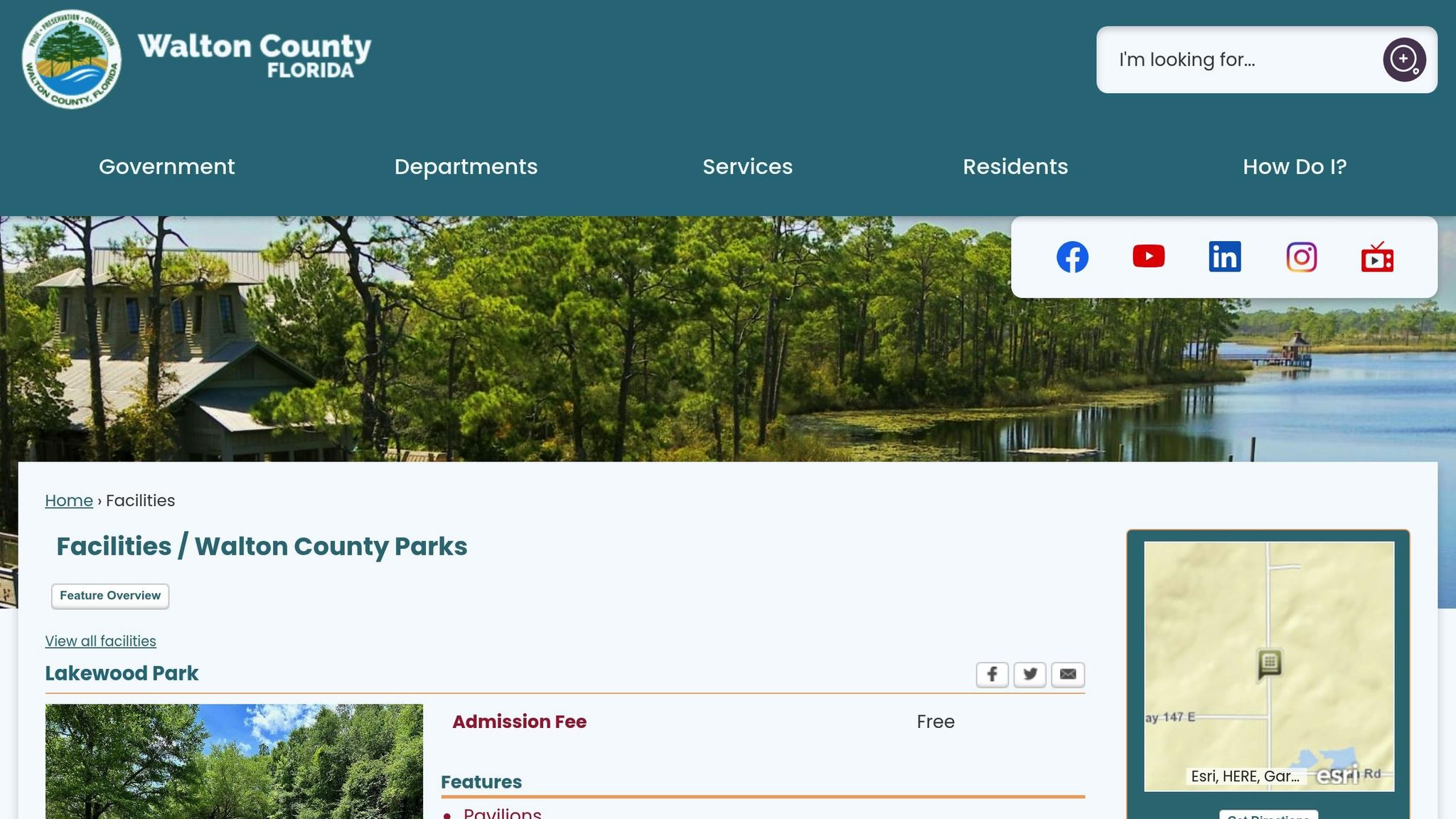
Nestled in DeFuniak Springs, Lakewood Park combines the serene beauty of Lake DeFuniak's waterfront with the charm of mature woodlands. This picturesque location offers a variety of settings that can elevate any nature photography project.
Photography Opportunities
The park's oak hammock areas create enchanting woodland scenes with dappled light filtering through the trees. Along the lake's edge, you'll find opportunities to capture stunning reflections and observe local wildlife. For those seeking broader perspectives, the elevated forested slopes provide sweeping views, with lush greenery adding depth and interest to your shots.
Access and Amenities
Lakewood Park welcomes visitors from dawn to dusk, making it easy to plan shoots during both sunrise and sunset. The park features well-marked trails that are easy to navigate, even with photography gear in tow. Parking is conveniently located near the main entrance, and the well-maintained paths ensure a hassle-free experience for photographers exploring the area.
Landscape Variety
What sets Lakewood Park apart is its harmonious blend of water and forest landscapes. Within a compact area, you can transition effortlessly from capturing expansive lakeside views to focusing on the intricate details of the dense forest. The towering, mature oaks add a sense of grandeur to your compositions, enhancing the visual appeal of every shot. This mix of aquatic and woodland settings mirrors the natural diversity Walton County is known for, all within one accessible location.
Best Photography Times
The golden hour - shortly after sunrise or just before sunset - is ideal for capturing the park's tranquil beauty, as the soft light highlights both the water and forest. Early mornings are especially peaceful, with fewer visitors and undisturbed wildlife, perfect for serene lake reflections and candid nature shots. Even on overcast days, the park offers evenly diffused light, making it a versatile destination for photography in any weather.
sbb-itb-d06eda6
4. Deer Lake State Park
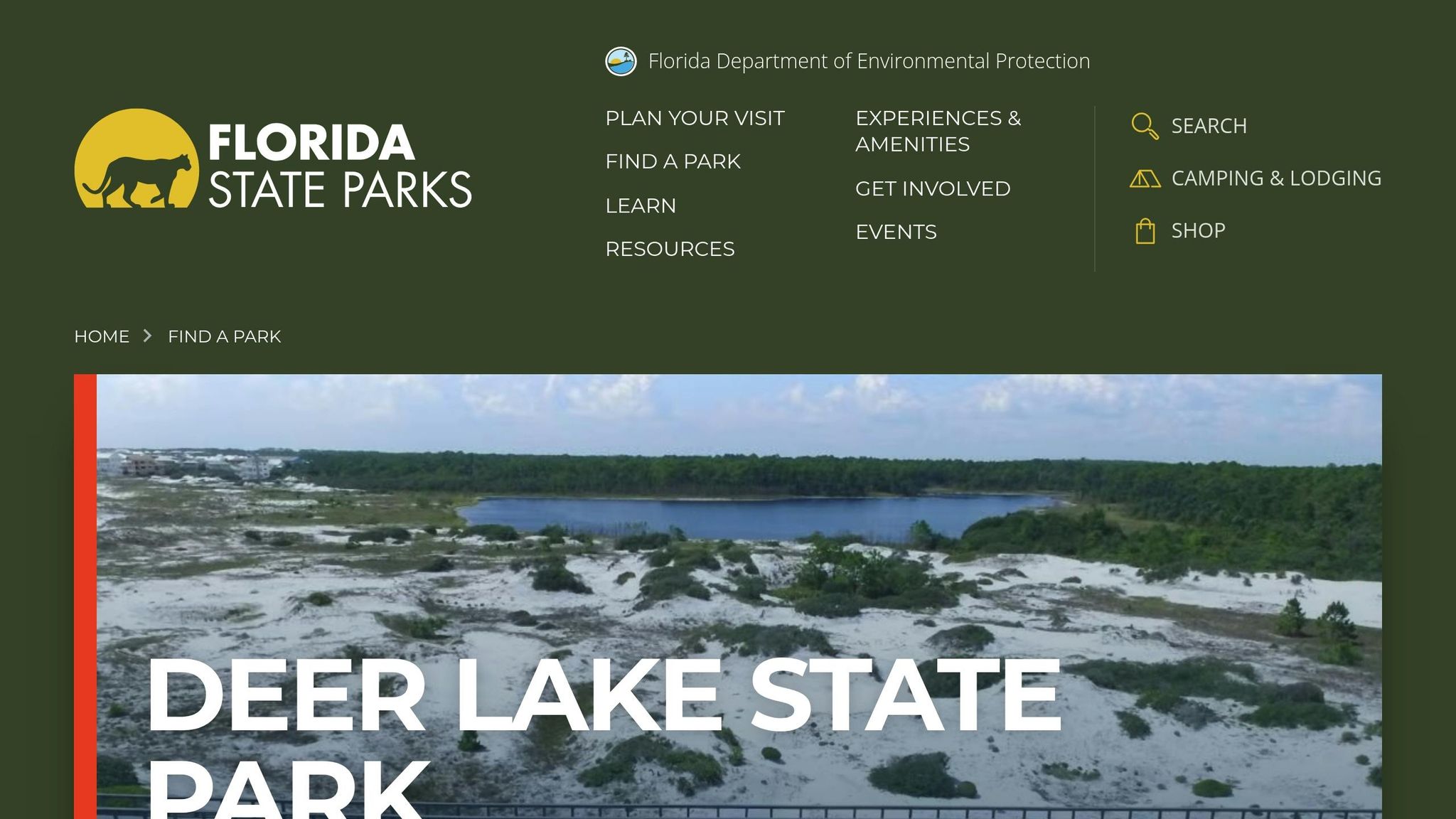
Spanning 1,800 acres, Deer Lake State Park is home to a rare coastal dune lake that flows directly into the Gulf of Mexico. This park showcases untouched ecosystems, making it a haven for photographers looking to document Florida's natural beauty.
Photography Opportunities
The heart of the park is its coastal dune lake, which offers stunning reflections and a chance to photograph wildlife like bald eagles, little blue herons, and reddish egrets. A quarter-mile boardwalk provides easy access to these sights. Add to that the dramatic contrast of towering sand dunes, emerald Gulf waters, and sugar-white beaches, and you’ve got a photographer’s dream backdrop. The wetlands, teeming with over 74,000 pitcher plants - including rare carnivorous species - are perfect for close-up, macro photography.
The park’s vegetation is equally captivating. Seasonal changes bring vibrant displays of native wildflowers like golden asters and the rare Gulf coast lupine. Meanwhile, pine forests along Scenic Highway 30A offer dense woodland scenes, making every visit a unique experience for photographers.
Access and Amenities
Deer Lake State Park is open daily, but planning ahead is crucial. The parking lot fills up quickly, especially during peak times, and the park may close temporarily when it reaches capacity. Arriving about 30 minutes before sunrise or sunset not only helps secure a parking spot but also ensures you’re there to capture the best lighting conditions.
The park is divided into two sections. The 139-acre "beach side" south of Scenic Highway 30A includes most of the coastal dune lake, while the larger 1,870-acre northern section features trails winding through serene pine forests. A thoughtfully designed boardwalk system makes it easy to navigate the park with your photography gear while protecting the delicate dune ecosystem.
Landscape Variety
Deer Lake State Park offers an incredible range of landscapes to explore. You can seamlessly move from photographing the coastal dune lake and Gulf views to wetlands, pine forests, and ancient dunes. From pitcher plant–filled marshes to pristine white sand dunes, the park provides endless opportunities to capture nature in its purest form.
Wildlife photographers will also find plenty to focus on, with species like Florida black bears, coyotes, snowy plovers, and butterflies adding to the park’s dynamic nature scenes.
Best Photography Times
The golden hours - early morning and late afternoon - are perfect for capturing soft shadows and vibrant colors. Coastal scenes, especially at sunrise or sunset, are particularly breathtaking. The reflections on the coastal dune lake during these times are unparalleled.
Arriving early not only ensures a parking spot but also allows you to enjoy the peaceful morning light when wildlife is most active. Thanks to the park’s Gulf Coast location, both sunrise and sunset create striking lighting conditions. Even on overcast days, the diffused light can bring out the intricate details of the park’s diverse plant life, making it an excellent setting for thoughtful, nature-focused photography.
5. Campbell Lake at Topsail Hill Preserve State Park
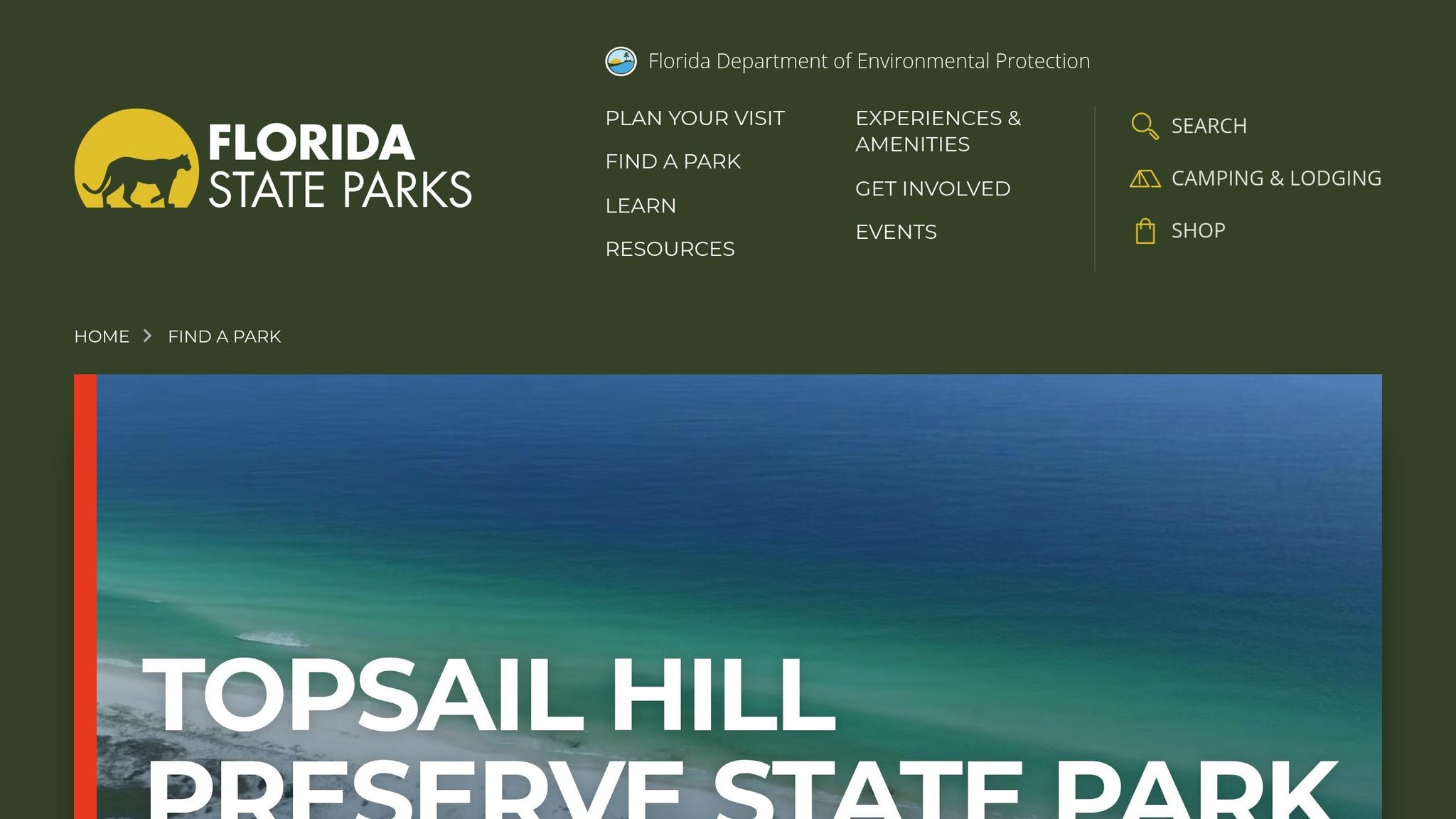
Campbell Lake is a haven for photographers eager to explore Florida's rare coastal dune lake environment. Nestled among towering sand dunes and surrounded by a mix of coastal ecosystems, the lake offers a stunning contrast to the nearby Gulf waters. This hidden treasure in Walton County combines tranquility with breathtaking natural beauty.
Photography Opportunities
The lake's still waters create incredible mirror-like reflections, making it a dream location for landscape and wildlife photography. Bird enthusiasts will find plenty to capture during migration seasons, as the area attracts a variety of waterfowl. For those who enjoy macro photography, the lake's edge is rich with intricate textures in native plants, offering plenty of fascinating close-up subjects.
Landscape Variety
The scenery around Campbell Lake transitions smoothly from coastal scrub and pine flatwoods to open areas framed by rolling sand dunes. This diverse landscape provides endless opportunities for photographers, from sweeping panoramic shots to detailed images of unique flora and terrain. The variety ensures every visit offers something new to capture.
Best Photography Times
"The golden hour after sunrise is absolutely prime time for wildlife watching at Topsail Hill Preserve State Park. This is when most animals are most active, the lighting is perfect for photography, and the park is peaceful before day-visitors arrive." – Coastal Coffee & Cafe 30a
For the best results, plan to visit within two to three hours after sunrise. Spring (March–May) and fall (September–November) are perfect for bird photography during migration periods, while winter (December–February) offers cooler temperatures ideal for long photography sessions. In the summer, aim for early mornings to avoid the intense Florida heat.
Look for clear, calm mornings with light winds to capture stunning reflections and active wildlife. Campbell Lake is truly a standout spot for nature photographers seeking both serenity and spectacular scenes.
Park Comparison Table
Here’s a handy table summarizing the standout features of each park mentioned earlier:
| Park | Best Photography Features | Accessibility | Amenities |
|---|---|---|---|
| Grady Brown Park | Stunning waterfront ambiance in Freeport | ADA-accessible facilities; easy boat ramp access | Boat ramp |
| Morrison Springs Park | Picturesque natural spring setting | Standard access with a boat ramp | Boat ramp; clean restrooms |
| Lakewood Park | Beautiful trails near Britton Hill | Accessible walking trail | Scenic trails |
| Deer Lake State Park | Coastal views along E. Highway 30A | 1.5-mile loop trail and boardwalk access | Boardwalk and beach access |
| Campbell Lake at Topsail Hill Preserve State Park | Expansive lake views along a paved bike path | 3.2-mile paved and accessible bike path | Paved bike path |
Each park offers something unique, whether it’s the tranquil waterfront at Grady Brown Park or the coastal charm of Deer Lake State Park. Accessibility ranges from ADA-friendly options at Grady Brown to scenic bike paths at Campbell Lake. Amenities also vary, with everything from boat ramps to boardwalks enhancing the visitor experience.
Conclusion
Walton County’s lesser-known parks are a treasure trove for nature photographers. From the serene reflections at Grady Brown Park to the crystal-clear waters of Morrison Springs Park, and from the tranquil trails of Lakewood Park to the coastal dune landscapes of Deer Lake State Park and Campbell Lake at Topsail Hill Preserve State Park, each location offers something special. These settings provide a variety of natural backdrops that highlight the county’s rich and diverse ecosystems.
These parks give photographers the chance to capture the untouched beauty of Walton County without interruption. Whether you’re after the perfect waterfront shot, a peaceful forest scene, or a coastal panorama, these parks cater to a wide range of creative visions.
As you explore, remember to prioritize the preservation of these natural spaces. Stick to marked trails, avoid disturbing wildlife, and follow the principles of Leave No Trace. Always pack out your trash and tread carefully around sensitive areas like water sources and nesting grounds to help maintain the beauty of these ecosystems for future visitors.
If you’re looking to uncover even more scenic gems, sowal.co is a fantastic resource. It regularly highlights additional photography spots throughout the South Walton area, offering insider tips to help you find those hidden locations that make the region so special.
Whether your passion lies in capturing shimmering water, lush forest paths, or sweeping coastal views, these parks provide endless inspiration for your photography journey. Be sure to visit sowal.co for even more hidden gems along South Walton’s stunning 30A coastline.
FAQs
When is the best time to visit Walton County’s hidden parks for nature photography?
The perfect time to explore Walton County’s hidden parks for nature photography is during the golden hour - about 45 minutes after sunrise or before sunset. This magical light bathes the landscape in soft, warm tones, making your photos truly stand out.
If you're planning a seasonal visit, spring and fall are your best bets. In spring, you'll find mild weather and vibrant blooms, while fall offers crisp air and a palette of colorful leaves, creating picture-perfect scenes. For an added bonus, head out early - around 8 a.m. - to dodge the harsher midday light and enjoy the cool, peaceful mornings.
Do I need any permits or fees for taking photos in Walton County parks?
For everyday photography in Walton County parks, you don’t need any permits or fees - feel free to snap away. But if you’re organizing a commercial shoot or a formal session, particularly on the beaches, you’ll need to secure a permit and provide liability insurance. The fees for these activities depend on the location and the nature of the shoot, so it’s best to contact local authorities ahead of time to get all the details sorted.
What are some tips for respecting nature and wildlife while taking photos in these parks?
When photographing in these parks, it’s important to respect nature and wildlife. Always maintain a safe distance from animals and let them go about their natural behaviors undisturbed. Feeding, baiting, or trying to attract wildlife for a photo might seem harmless but can actually harm the animals and disrupt their environment.
Stick to Leave No Trace principles by staying on designated trails, minimizing any damage to vegetation, and disposing of waste responsibly. Quiet observation or using tools like a blind can help you get incredible shots without stressing the wildlife. By following these guidelines, you help preserve the environment for others and protect the habitats you’re there to admire.
